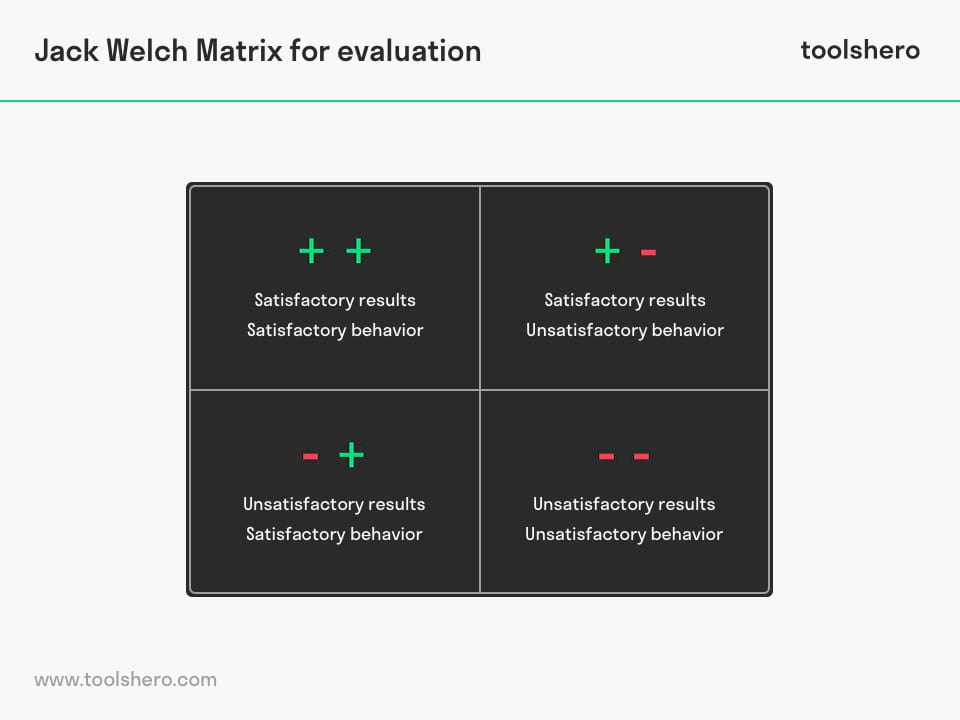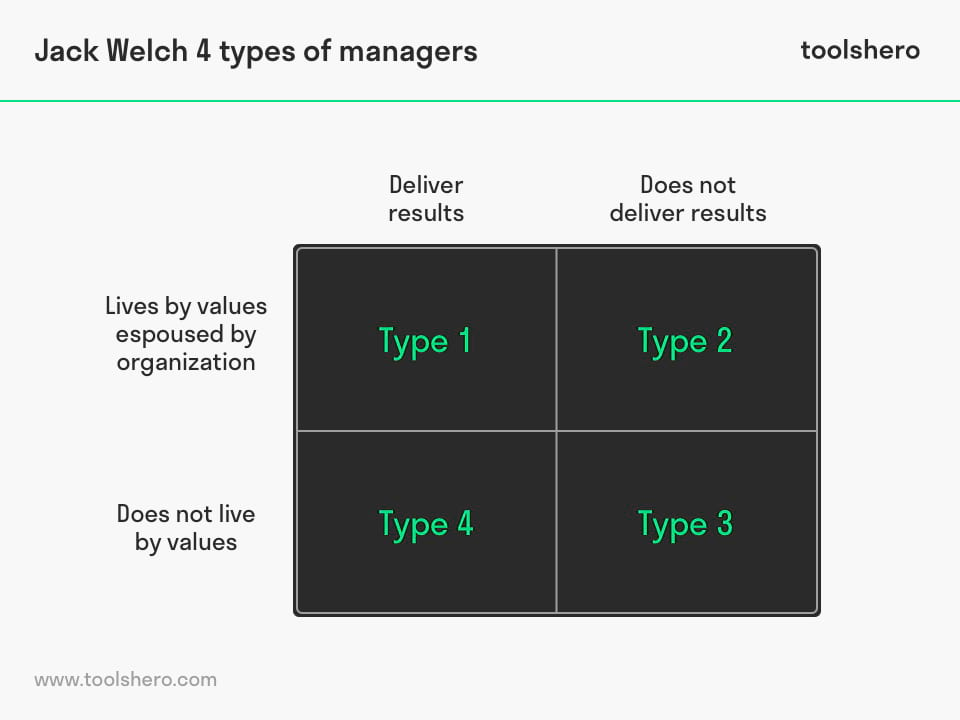Jack Welch Matrix

Jack Welch matrix: this article explains the Jack Welch matrix in a practical way. After reading, you’ll understand the basics of this powerful human resource management tool.
What is the Jack Welch matrix?
The Jack Welch matrix is a human resource management tool that was originally designed for assessing managers at the American General Electric (GE) company.
However, the tool can also be used to assess employees across the entire organisation. The evaluation of employees and managers in the Jack Welch matrix is based on two points.
The human resource management tool was developed by John Francis Welch Jr., better known as Jack Welch. For twenty years, he was the chairman and chief executive officer (CEO) of General Electric (GE).
Under his leadership, the company grew strongly, and other CEOs started to follow his policy as well. Jack Welch played a great role in redefining the concept of leadership and created a role for the support and assessment of other managers.
Jack Welch matrix for evaluation
First, the employee’s or manager’s results and performances are assessed. At the human resource manager department, various kinds of information about the employees are available. These may include assessment interviews, progress interviews, absentee records, or other personal information. Assessment of the results requires a skilled manager, who approaches the information with the right methods. The outcome on the point of behaviour is positive or negative.
The employee’s or manager’s behaviour is closely examined as well. In the employee’s case, it’s about behaviour in the workplace, interactions with others, communication styles, or other features. In the manager’s case, it’s about the use of various management styles.
According to Jack Welch, it’s important for the manager to act in accordance with the organisation’s values and mission.
When these dimensions are combined, a matrix appears with the following four quadrants:
Plus-plus
The managers and employees who fall into this category of the Jack Welch matrix passed the assessment in a positive way. These employees are an example to the others and are a perfect fit with the organisation’s vision and methods. The behaviour is positive and strengthens the motivations of others, and the performance and results are good to excellent.
Plus-minus
These employees or managers did not pass the evaluation in a fully positive way. Their score on behaviour was insufficient. If the behaviour is slightly deviant or undesirable, it can be improved and trained. If the behaviour is entirely unacceptable, or impacts others negatively, dismissal often follows.
Minus-plus
This group of candidates was not assessed entirely positively either. In this case, it’s the results that are insufficient. The results may deviate slightly from expectations, in which case improvement is still possible.
If results are definitely insufficient, a transfer may be considered. If results are entirely lacking, dismissal may follow.
Minus-minus
This group of employees or managers failed to score a passing mark on both criteria, and they are usually fired immediately.
This group of employees do not deliver good results, and their unsuitable behaviour has a negative influence on the rest of the employees. It’s better for the morale among the other colleagues if such colleagues disappear from the workplace.
Jack Welch Matrix: Jack Welch’s Four Types of Managers
Apart from the Jack Welch matrix as described above, Jack Welch created another matrix. This matrix is somewhat similar to the tool for assessing employees and managers, but this matrix only shows four types of managers.
He described these four categories of managers in General Electric’s 2000 annual report. Jack Welch was the chairman of GE from 1981 to 2001.
The two dimensions used are results and values. ‘Values’ indicates whether a manager represents the values of the organisation, and whether they fully support the organisation’s identity.
Manager type 1
This is an exemplary manager from the Jack Welch matrix. The manager represents the organisation’s values and projects this to others within the organisation. For these managers, the sky is the limit!
Manager type 2
This type of manager from the Jack Welch matrix represents the organisation’s values and shows it, but lacks the good results that are necessary to retain their function. Such managers are usually given another chance, or even two. Should results not improve then, a transfer or another option often follows.
Manager type 3
These are the managers each organisation would rather get rid of. The type 3 manager does not represent the organisation’s values and projects nothing but negativity. These managers also fail to produce adequate results. Such dysfunction can have various causes. The reality is that these managers are removed from the organisation with priority.
Manager type 4
The type 4 manager, according to Jack Welch, is the most difficult one of all. That’s because this manager does not represent the organisation’s values and does not project them.
The organisation would rather let these managers go. However, type 4 managers are skilled and deliver good results. Hence, it is a difficult decision for many companies.
It’s not easy to let go of a manager who delivers good results, and yet they have to go because they have the power to change the entire organisational culture. They could destroy the open and informal system, based on trust, in the blink of an eye.
Jack Welch Matrix summary
The contributions made by Jack Welch during his time on the board of General Electric have yielded more than just success for General Electric.
Over the years, thousands of managers and employees around the world have been in contact by human resource management tools that include Jack Welch’s assessment matrix. He first developed a matrix for evaluation based on the two dimensions of behaviour and results.
Later, in General Electric’s 2000 annual report, he wrote about the four types of managers he sees in the organisation. According to him, all organisations should do whatever they can to bring in type 1 managers.
Type 4 managers should be let go as soon as possible. They influence the organisation and all its employees in a negative way.
Now it’s your turn
What do you think? Do you recognise the explanation about the Jack Welch matrix? What do you think are the pros and cons of using this model in human resource management? What methods are used for evaluation and assessment in your environment? What would you take into account during an assessment or evaluation? Do you have any tips or additional comments?
Share your experience and knowledge in the comments box below.
More information
- Lowe, J. (2009). Jack Welch Speaks. John Wiley & Sons.
- Slater, R. (2003). Jack Welch and the GE Way. Tata McGraw-Hill Education.
- Welch, J., & Byrne, J. A. (2003). Jack: Straight from the gut. Business Plus.
- Welch, J. (2014). Jack: What I’ve learned leading a great company and great people. Hachette UK.
How to cite this article:
Janse, B. (2019). Jack Welch Matrix. Retrieved [insert date] from toolshero: https://www.toolshero.com/human-resources/jack-welch-matrix/
Published on: 26/09/2019 | Last update: 02/10/2022
Add a link to this page on your website:
<a href=”https://www.toolshero.com/human-resources/jack-welch-matrix/”>toolshero: Jack Welch Matrix</a>














